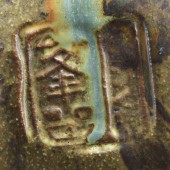![]() Printer version
Printer version
Paul Chaleff
1947Born
EDUCATION
1969BA Fine Arts, City College of New York, New York, New York
1971MFA Ceramics, City University of New York, New York, New York
PRIMARY WORK EXPERIENCE
1997—Professor of Art, Hofstra University, Hempstead, New York
BIOGRAPHY
Paul Chaleff is known for his large scale wood fired ceramic sculptures and vessels. He also created a large body of wheel thrown functional vessels. His vessels are strongly influenced by Japanese pottery, especially the work of one of Japan’s National Living Treasures, Takeshi Nakazato. Chaleff was one of the first American potters using a Japanese style Anagama kiln and became a leader in the introduction of this form of wood-burning kiln.
In 1989, he began a regular collaboration with the British sculptor Sir Anthony Caro. Over a period of thirteen years, they created nearly 50 works, both figurative and abstract. Caro’s sculpture has had direct influence on Chaleff’s work as has the sculpture of Isamu Noguchi, and the ceramics of John Mason and Lucie Rie.
PUBLIC COLLECTIONS
Allentown Museum of Art, Allentown, Pennsylvania
American Museum of Ceramic Art, Pomona, California
Arizona State University Art Museum, Tempe, Arizona
Arkansas Arts Center, Little Rock, Arkansas
Arrowmount School of Arts and Crafts, Gatlinburg, Tennessee
Boise Art Museum, Boise, Idaho
Brooklyn Museum, Brooklyn, New York
Carnegie Institute Museum of Art, Pittsburgh, Pennsylvania
City College of New York, New York, New York
Crocker Museum of Art, Sacramento, California
Everson Museum of Art, Syracuse, New York
Idyllwild School of Music and Art, Idyllwild, California
Longhouse Foundation, Easthampton, New York
Los Angeles County Museum of Art (LACMA), Los Angeles, California
Metropolitan Museum of Art, New York, New York
Mills College, Oakland, California
Muju Sculpture Park, South Korea
Museum of Arts and Design, New York, New York
Museum of Fine Arts, Boston, Massachusetts
Museum of Modern Art, New York, New York
Princeton University Art Museum, Princeton, New Jersey
Racine Art Museum, Racine, Wisconsin
Rockefeller University, New York, New York
Smithsonian American Art Museum, Renwick Gallery, Washington, DC
University of Colorado Art Museum, Boulder, Colorado
Yale University Art Gallery, New Haven, Connecticut
BIBLIOGRAPHY
Adlin, Jane. Contemporary Ceramics: Selections from the Metropolitan Museum of Art. New York: Metropolitan Museum of Art, 1998.
Bach, Laurence. “Connecting Cultures: Paros Island Greece 2005,” Ceramics Technical (2006).
Bischoff, Dan. “Exploring the Complexities of Clay,” The Star Ledger, Sunday May 8, 2008.
Caro, Anthony. Clay Sculptures. London, England: Galerie Bresson, 2002.
Court, Louise Allison. “A Short History of Woodfiring in America.” The Log Book 9 (2002).
DuBois, Alan and Michael Monroe. Living with Form: The Horn Collection of Contemporary Crafts. Little Rock, AK: Arkansas Arts Center, 2000.
Esman, Abigail. “Shaped by Tragedy.” American Style, June 2005.
Fairbanks, Jonathan, Angela Fina, and Christopher Gustin. The Contemporary Potter. Rockport, MA, Rockport Publishers, 2000.
Genoccio, Benjamin. “Masterful Sculptures, Formed of Clay.” New York Times, July 27, 2008.
Goddard, Dan R. “Southwest School’s Vessels Stress Form Over Function.” San Antonio Express News, October 2, 2005.
Lebow, Edward. “Paul Chaleff.” American Ceramics (May 1983).
Lombardi, Dominick. “Inside Out.” New York Times, Westchester Ed.,August 15, 2004.
Pearson, Katherine. Crafts, a Resource Book. New York, NY: Stewart Tabori and Chang, 1984.
Patricia Pelehach. “Paul Chaleff’s Re-Engineered Vision.” Ceramics Art and Perception (April 2006).
Peterson, Susan. Contemporary Ceramics. New York: Watson Guptill, 2000.
_____________. The Craft and Art of Clay. New York: Prentice Hall, 2000.
_____________. Working With Clay. New York: Prentice Hall, 1999.
Rhodes, Daniel and Robin Hopper. Clay and Glazes for the Potter. London: Black Publishing, 2000.
Schwartz, Judith. “Paul Chaleff at Paula Allen.” American Ceramics (1990).Shen, Henry. “Paul Chaleff.” Taiwan Ceramic Art (August 1996).
Spyridoyannakis, Marsh. “Art and Tradition: Connecting Cultures in Paros.” Paros Life (August 2005).
Tsoukanelis, Erika Alexi. “A View to Dream.” Inside Out (July/August 2008).
Williams, Gerry. “The Japanese Pottery Tradition and its Influence on American Ceramics.” American Craft (April/May 1998).
WEBSITE(S):
Japanese-style "chop" mark or inscribed "Chaleff" signature with date.
Citation: "The Marks Project." Last modified February 15, 2024. http://www.themarksproject.org:443/marks/chaleff
















